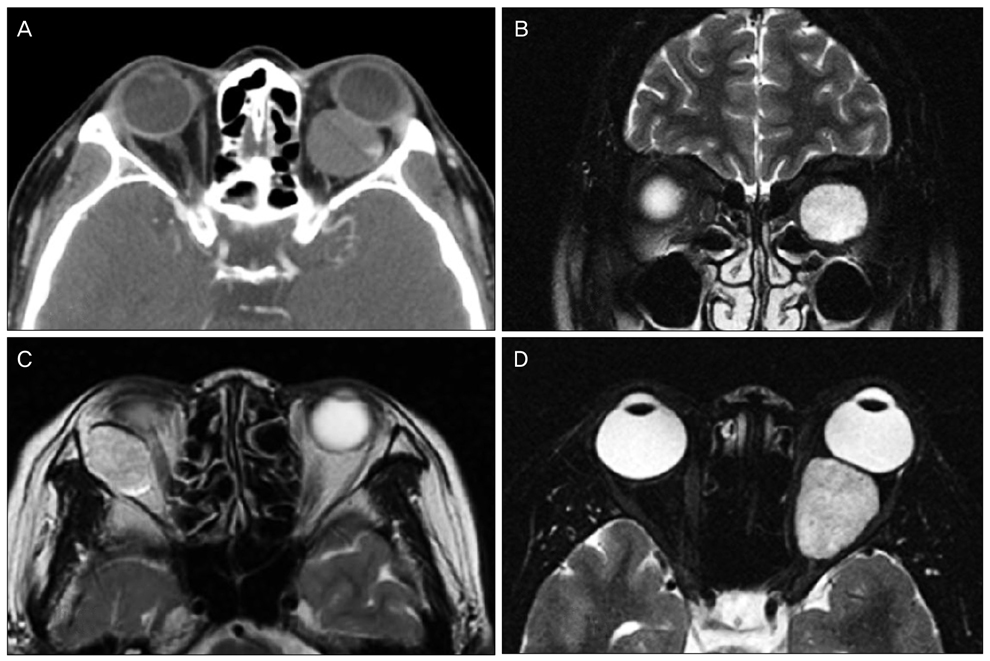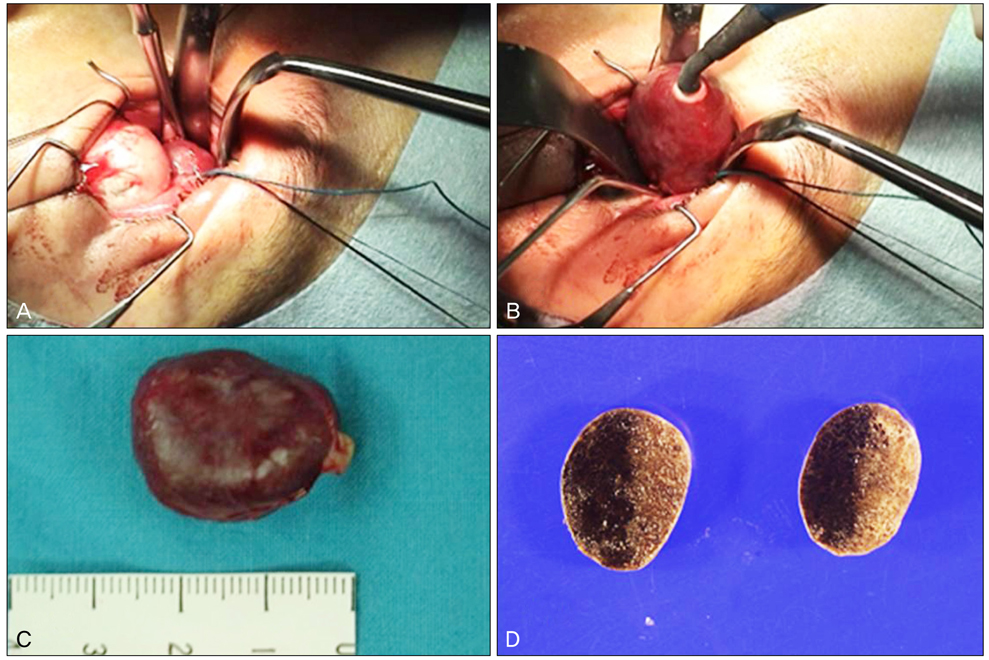Korean J Ophthalmol.
2010 Oct;24(5):274-278. 10.3341/kjo.2010.24.5.274.
Surgical Outcomes of Transconjunctival Anterior Orbitotomy for Intraconal Orbital Cavernous Hemangioma
- Affiliations
-
- 1Department of Ophthalmology and Visual Science, Seoul St. Mary's Hospital, The Catholic University of Korea School of Medicine, Seoul, Korea. yswoph@catholic.ac.kr
- KMID: 974320
- DOI: http://doi.org/10.3341/kjo.2010.24.5.274
Abstract
- PURPOSE
To describe surgical outcomes for transconjunctival anterior orbitotomy for intraconal cavernous hemangiomas.
METHODS
The medical records of 9 consecutive patients with intraconal cavernous hemangiomas who underwent surgical removal by transconjunctival anterior orbitotomy were retrospectively reviewed. The conjunctiva was incised and retracted with a traction suture. For large tumors, a rectus muscle was temporarily disinserted. Tenon's capsule was separated and the tumor was removed with a cryoprobe or clamp. Surgical outcomes, positions of the tumors, methods of approach, and intra- and post-operative complications were evaluated.
RESULTS
The mean follow-up period was 33 +/- 6.8 months. No bony orbitotomy was used in this technique and the cosmetic results were very satisfactory. All tumors were removed intact. In 4 patients, tumors were extirpated with the aid of a cryoprobe. No patients had residual proptosis or limitation of ocular movement. No signs of recurrence were noted in any cases at 33 months follow-up. No serious or permanent complications were observed during or after the operation.
CONCLUSIONS
Transconjunctival anterior orbitotomy is an important surgical procedure in the treatment of intraconal cavernous hemangiomas. It can produce an excellent result, even if the posterior border of the tumor abuts the orbital apex.
Keyword
MeSH Terms
Figure
Reference
-
1. Casper DS, Chi TL, Trokel SL. Orbital disease: imaging and analysis. 1993. New York: Thieme Medical Publisher;81–97.2. Scheuerle AF, Steiner HH, Kolling G, et al. Treatment and long-term outcome of patients with orbital cavernomas. Am J Ophthalmol. 2004. 138:237–244.3. Rootman J. Diseases of the orbit: a multidisciplinary approach. 2003. 2nd ed. Philadelphia: Lippincott Williams & Wilkins;420–460.4. Forrest AW. Intraorbital tumors. Arch Ophthal. 1949. 41:198–232.5. Knapp H. A case of carcinoma of the outer sheath of the optic nerve, removed with preservation of the eyeball. Arch Ophthalmol Otol. 1874. 4:323–354.6. Yan J, Wu Z. Cavernous hemangioma of the orbit: analysis of 214 cases. Orbit. 2004. 23:33–40.7. Harris GJ, Jakobiec FA. Cavernous hemangioma of the orbit. J Neurosurg. 1979. 51:219–228.8. McNab AA, Wright JE. Cavernous haemangioma of the orbit. Aust N Z J Ophthalmol. 1989. 17:337–345.9. Asregadoo ER. Retrobulbar cavernous hemangioma with slowly progressive proptosis. Ann Ophthalmol. 1979. 11:375–378.10. Shields JA, Shields CL, Eagle RC. Cavernous hemangioma of the orbit. Arch Ophthalmol. 1987. 105:853.11. Hood CI. Cavernous hemangioma of the orbit. A consideration of pathogenesis with an illustrative case. Arch Ophthalmol. 1970. 83:49–53.12. McCord CD Jr, Moses JL. Exposure of the inferior orbit with fornix incision and lateral canthotomy. Ophthalmic Surg. 1979. 10:53–63.13. Geyer O, Godel V, Lazar M. Transconjunctival approach for intraorbital tumors. Arch Ophthalmol. 1988. 106:14–15.14. Silkiss RZ, Carroll RP. Transconjunctival surgery. Ophthalmic Surg. 1992. 23:288–291.15. Mullins JB, Holds JB, Branham GH, Thomas JR. Complications of the transconjunctival approach: a review of 400 cases. Arch Otolaryngol Head Neck Surg. 1997. 123:385–388.
- Full Text Links
- Actions
-
Cited
- CITED
-
- Close
- Share
- Similar articles
-
- Vascular hamartoma of the orbit
- A case report of large orbital cavernous hemangioma treated with inferolateral orbitomomy
- Large Orbital Cavernous Hemangioma: A Case Report
- The transconjunctival approach to a large retrobulbar cavernous hemangioma of the orbit
- Skeletal cavernous hemangiomas of the frontal bone with orbital roof and rim involvement



